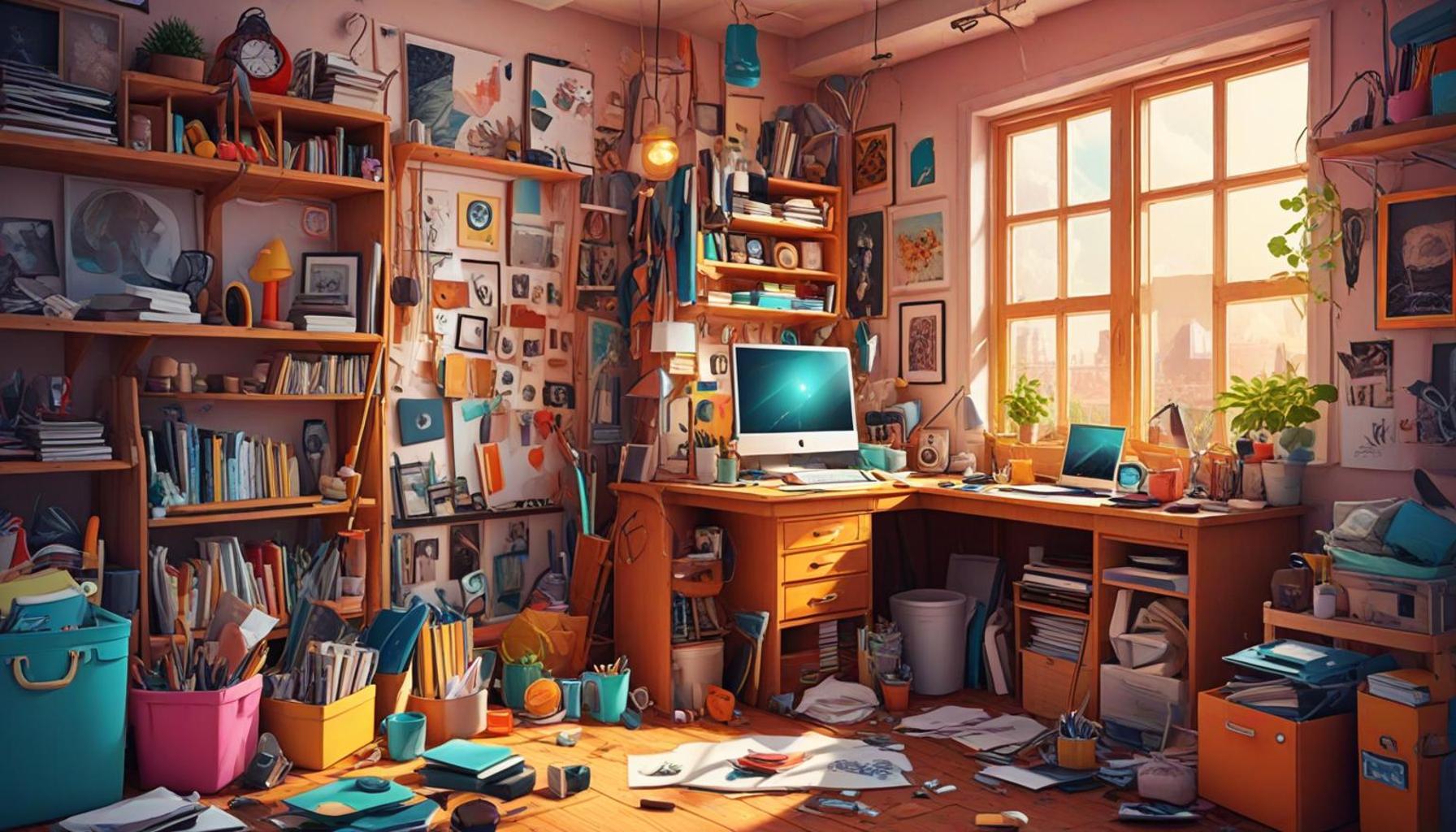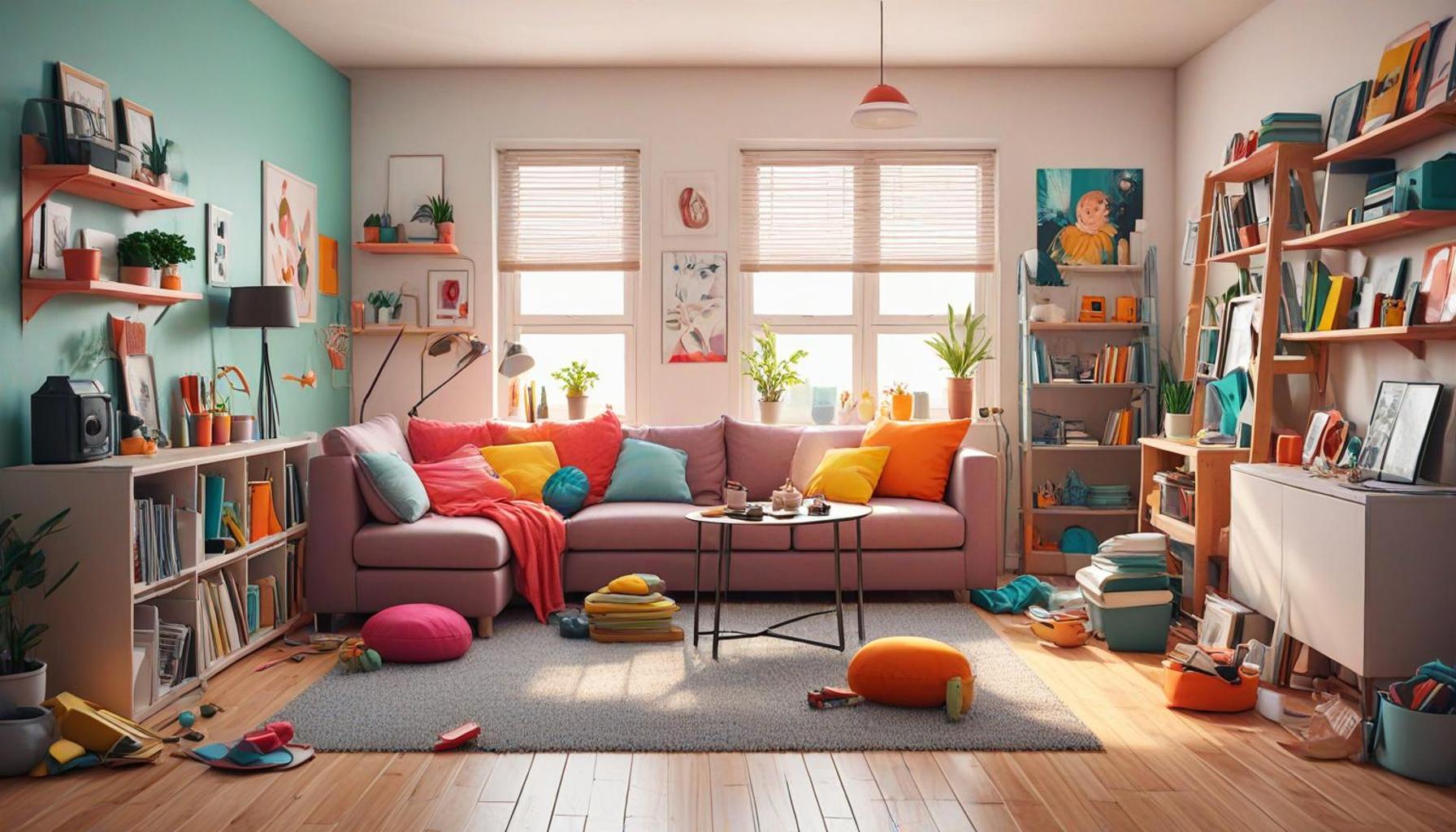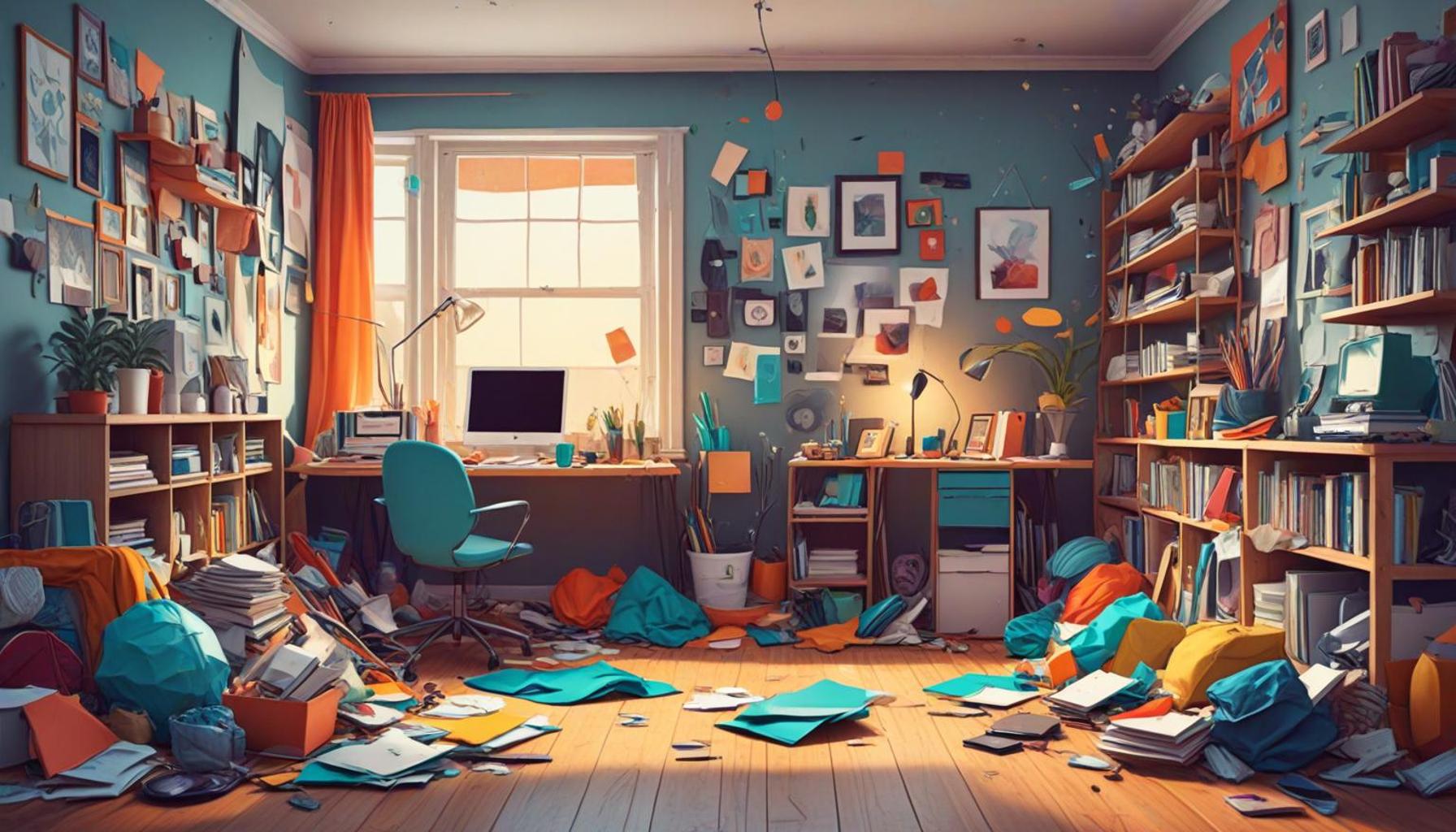Clutter and Creativity: Finding Inspiration in Organized Spaces

Unlocking Inspiration Through Organization
In today’s fast-paced world, individuals constantly navigate a myriad of distractions that can hinder their creative potential. Whether in a bustling city or a quiet suburb, the interplay between chaotic environments and creativity reveals a fascinating dynamic. Many artists, writers, and innovators have discovered that seeking sanctuary in organized spaces can significantly enhance their creative output. By understanding the relationship between clutter and creativity, one can unlock new dimensions of inspiration.
Consider the notion of clutter as chaos. Studies show that excessive disarray can overwhelm the mind, leading to heightened stress levels and distraction. For instance, artists like Jackson Pollock thrived in chaotic environments, yet many of their contemporaries were known to prefer more structured spaces to concentrate. The contrast serves as a reminder that while some individuals find freedom in mess, for others, a cluttered space can stifle innovative thoughts, rendering their ideas trapped amidst the chaos.
On the flip side, order as freedom can create a conducive environment for creativity to flourish. An organized workspace often fosters clearer thinking, paving the way for heightened productivity. Research from the Princeton University Neuroscience Institute demonstrates that participants working in organized environments performed better on cognitive tasks compared to those in disorganized settings. It illustrates how a tidy space invites mental clarity, allowing creativity to flow more freely without the constant interruptions that clutter may present.
Moreover, personal reflection through organization offers a unique pathway to creative expression. An individual’s method of arranging their workspace can reflect their personal style and inspire innovative ideas. For example, a writer’s desk adorned with inspirational quotes, photographs, or art pieces can serve as a daily reminder of their creative purpose. This distinctive environment encourages self-reflection, which can lead to breakthroughs in artistic vision.
Notable figures like Steve Jobs and Maya Angelou exemplified the power of maintaining order in their surroundings. Jobs famously emphasized simplicity in both his work ethic and design philosophy, arguing that a clear and minimalistic workspace was essential for nurturing creativity. Similarly, Angelou would often write in hotel rooms that she meticulously organized to avoid distractions, showcasing that the spaces we inhabit can profoundly impact our creative endeavors.

This relationship prompts essential inquiries: How does physical organization truly influence creative output? Can transforming a workspace into an inspiring haven deepen one’s artistic vision? As we explore the intricate connection between clutter and creativity, it’s essential to acknowledge that each individual must find their unique balance between chaos and order.
Fortunately, practical strategies exist to cultivate an environment that stimulates innovation. Start by decluttering your space systematically—removing items that no longer serve a purpose. Next, introduce elements that resonate with your personal style, such as art, plants, or comfortable furniture. Finally, consider the layout of your workspace: ensuring that it inspires productivity and creativity can be transformative.
As we continue to delve into this captivating relationship, it becomes clear that the journey of organizing one’s surroundings may not only boost productivity but also unveil a landscape ripe for creativity, allowing individuals to discover their own path to inspiration.
DISCOVER MORE: Click here to learn about the emotional benefits of decluttering
The Dual Nature of Clutter and Creativity
Understanding the dichotomy of clutter and creativity is crucial for unlocking new avenues of inspiration. On one hand, the chaotic allure of clutter can evoke a sense of freedom and spontaneity. Yet, on the other end of the spectrum, a well-ordered environment can encourage focus and unbridled creativity. This duality raises the intriguing question: What specific aspects of our surroundings can trigger a creative breakthrough?
Research has shown that the effect of clutter on creativity is largely subjective. For some, a pile of unorganized materials may act as a launching pad for innovative ideas, providing a wealth of resources from which to draw inspiration. In contrast, many individuals find that too much disarray leads to cognitive overload, inhibiting their ability to concentrate effectively. This response can vary based on personal preferences and work styles, indicating that embracing one’s unique clutter threshold is key.
Furthermore, science supports the notion that organized spaces can lead to productivity enhancement. A study conducted by researchers at the University of Southern California discovered that individuals engaged in creative tasks performed significantly better when working in tidy environments. Participants reported feeling less distracted and more capable of developing novel ideas compared to those in areas filled with disordered elements. This study draws a compelling connection between mental clarity and workspace organization, providing insight for those seeking a creative boost.
Here are some practical observations about how specific elements of your space can either clutter or inspire:
- Light Levels: Natural light can elevate mood and stimulate creativity, whereas dim, cluttered areas may feel stifling.
- Furniture Arrangement: Open layouts can foster collaboration and movement, while cramped spaces may inhibit creativity.
- Color Schemes: Bright colors can invigorate and motivate, whereas muted hues may promote calmness and focus.
As we consider the psychological impact of the environment, it’s worth noting the concept of environmental psychology. This field explores how our surroundings influence our behaviors and emotions, shedding light on the powerful effects of organized versus disorganized spaces on our cognitive processes. The principles derived from this discipline can guide individuals in creating their own inspirational sanctuaries.
Moving beyond personal preferences, it’s essential to consider how social and cultural factors can also play a significant role in shaping our ideas about clutter and creativity. In many creative circles, the stereotype of the “tortured artist” often implies that chaos begets innovation. Yet, this stereotype overlooks the success of many who thrive in organized settings. A closer examination reveals that effective organization not only contributes to personal productivity but can also enhance collaborative efforts in team-oriented creative environments.
The importance of balancing clutter and cleanliness cannot be understated. As we experiment with different organizational techniques, we can learn how to tailor our spaces to better reflect our own creative processes. By preemptively identifying what promotes distraction for us and what inspires imaginative thinking, we position ourselves to harness our full creative potential.
Exploring the Intersection of Clutter and Creativity
The relationship between clutter and creativity is one that warrants a deeper examination. Organized spaces have shown to foster creativity by providing a clearer mental path for ideas to flow. When your environment is tidy and well-structured, it allows your mind to focus more on innovative thinking rather than getting distracted by chaos.
Interestingly, studies suggest that environments cluttered with inspiration—think art supplies, design materials, or eclectic decor—actually enhance creativity by providing diverse stimuli to engage with. The key lies in balance; while some degree of clutter can spark ideas, excessive disorganization may impede productivity.
Creating Your Ideal Space
In creating a space that stimulates your creative juices, consider incorporating zones meant for different activities, allowing you to switch gears effectively. For instance, having a dedicated corner for brainstorming, another for crafting, and a tidy desk for executing ideas can help strike that essential balance. Additionally, integrating elements like natural light and plants can elevate the atmosphere, making your space more inviting.
| Category | Benefits |
|---|---|
| Cleanliness | A neat environment encourages productivity and focus. |
| Inspiration Zones | Designated areas for creativity can foster free-thinking and inspire new ideas. |
Adopting an organized yet creatively inspiring space can lead not only to improved results in your work but also a deeper sense of satisfaction. Tailoring your environment to encourage creativity is a step towards unearthing your potential.
DISCOVER MORE: Click here to learn about the importance of intention in crafting a minimalist space
Transformative Power of Organized Spaces
The intricacies of how clutter and creativity interact extend beyond merely aesthetic considerations; they invite a deeper exploration of how organization can be a catalyst for artistic expression. One compelling aspect is the idea of place attachment, which reflects our emotional bond with certain environments. When spaces are organized thoughtfully, they can foster a sense of belonging and security, allowing individuals to feel more at ease during the creative process. This emotional safety can free up mental resources that can be redirected toward innovation and imaginative exploration.
Notably, the concept of workspace personalization plays a significant role in this equation. Personalized elements in a workspace can boost motivation and spark creativity by making individuals feel more connected to their tasks. A study by researchers at Harvard Business School revealed that employees who personalized their workspaces reported enhanced creativity and satisfaction, suggesting that an organized yet personalized setting can help individuals channel their creative energies more effectively.
Let’s take a closer look at specific organizational strategies that can fuel inspiration:
- Decluttering Rituals: Regularly assessing and removing items that no longer serve a purpose can clear mental space. A decluttering routine can significantly impact one’s ability to think clearly and creatively.
- Functional Zones: Creating designated areas for different types of work—like brainstorming, executing, or brainstorming—can improve focus and organization, making it easier to flow between creative processes.
- Minimalist Design: Embracing a minimalist approach doesn’t mean stripping away character; rather, it can emphasize functionality while reducing distractions, allowing ideas to flourish.
Moreover, the impact of digital clutter cannot be overlooked. In our increasingly digital world, overflowing inboxes, chaotic file management systems, and an excess of unopened tabs can be just as detrimental to creativity as a disorganized physical space. Adopting digital organization tools such as task management apps can streamline workflows, leading to a clearer mental state and more headspace for creativity.
Another vital element is mobility. Spaces that allow for physical movement—be it standing desks, movable furniture, or team collaboration areas—encourage not just collaboration but also ignites creative thought. Many companies are beginning to understand the importance of spatial dynamics, designing their offices with mobility in mind to stimulate a culture of creativity. The popular trend of open office designs, while sometimes controversial, is rooted in the understanding that connection and movement can amplify innovative thinking.
As we dissect this relationship between organization and creativity, let’s also consider the role of nature. Incorporating natural elements like plants or views of greenery can profoundly affect creativity and well-being. Studies indicate that nature boosts mood and cognitive functioning, serving as a backdrop that inspires artistic ideation. For instance, the addition of plants in a workplace can enhance productivity by reducing stress levels and creating a calming atmosphere conducive to creative thought.
The art of curating one’s environment reflects individuality and can ultimately shape a personalized creative journey. Engaging with these elements will enable people to find not only practical solutions but also inspirational touchpoints in their organized spaces.
DISCOVER MORE: Click here to uncover creative space solutions
Embracing Organization for Creative Flourishing
In a world brimming with distractions and overwhelming choices, the symbiosis between clutter and creativity presents an opportunity to reshape how we engage with our environments. By adopting thoughtful organizational strategies, we not only cultivate physical spaces conducive to creativity but also nurture emotional and cognitive well-being. The understanding that place attachment and workspace personalization directly influence our creative output encourages individuals to take ownership of their surroundings, thereby enhancing motivation and innovative thinking.
As explored, practices such as decluttering rituals, establishing functional zones, and embracing a minimalist design can transform any workspace into a sanctuary for creativity. Furthermore, addressing digital clutter and incorporating elements of mobility into our daily routines can launch us into new heights of productivity and inspiration.
Ultimately, the essence lies in recognizing that our environments are more than mere backdrops; they are vibrant catalysts for creative expression. By infusing natural elements and personal touches into our organized spaces, we can unlock the full potential of our imaginative capacities. As we continue to navigate through the bustling landscape of modern living, it becomes increasingly clear that embracing organization is not just a method but a profound strategy for fostering creativity, offering a pathway to a more inspired and fulfilled life. Making this conscious effort can redefine our relationships with our environments, inviting creativity to flow freely and effortlessly into our lives.



